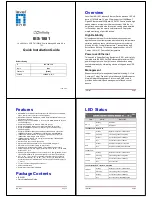
1-2
Figure 1-1
Dynamic domain name resolution
Figure 1-1
shows the relationship between the user program, DNS client, and DNS server.
The resolver and cache comprise the DNS client. The user program and DNS client can run on the
same device or different devices, while the DNS server and the DNS client usually run on different
devices.
Dynamic domain name resolution allows the DNS client to store latest mappings between domain
names and IP addresses in the dynamic domain name cache. There is no need to send a request to the
DNS server for a repeated query next time. The aged mappings are removed from the cache after some
time, and latest entries are required from the DNS server. The DNS server decides how long a mapping
is valid, and the DNS client gets the aging information from DNS messages.
DNS suffixes
The DNS client normally holds a list of suffixes which can be defined by users. It is used when the name
to be resolved is incomplete. The resolver can supply the missing part. For example, a user can
configure com as the suffix for aabbcc.com. The user only needs to type aabbcc to get the IP address of
aabbcc.com. The resolver can add the suffix and delimiter before passing the name to the DNS server.
z
If there is no dot in the domain name (for example, aabbcc), the resolver will consider this a host
name and add a DNS suffix before query. If no match is found after all the configured suffixes are
used respectively, the original domain name (for example, aabbcc) is used for query.
z
If there is a dot in the domain name (for example, www.aabbcc), the resolver will directly use this
domain name for query. If the query fails, the resolver adds a DNS suffix for another query.
z
If the dot is at the end of the domain name (for example, aabbcc.com.), the resolver will consider it
a fully qualified domain name (FQDN) and return the query result, successful or failed. Hence, the
dot (.) at the end of the domain name is called the terminating symbol.
Currently, the device supports static and dynamic DNS services.
If an alias is configured for a domain name on the DNS server, the device can resolve the alias into the
IP address of the host.
Summary of Contents for S7906E - Switch
Page 82: ...1 4 DeviceA interface tunnel 1 DeviceA Tunnel1 service loopback group 1...
Page 200: ...1 11 DeviceB display vlan dynamic No dynamic vlans exist...
Page 598: ...ii...
Page 1757: ...4 9...
Page 1770: ...6 4...
Page 2017: ...2 11 Figure 2 3 SFTP client interface...
Page 2238: ...1 16 DeviceA cfd linktrace service instance 1 mep 1001 target mep 4002...
















































